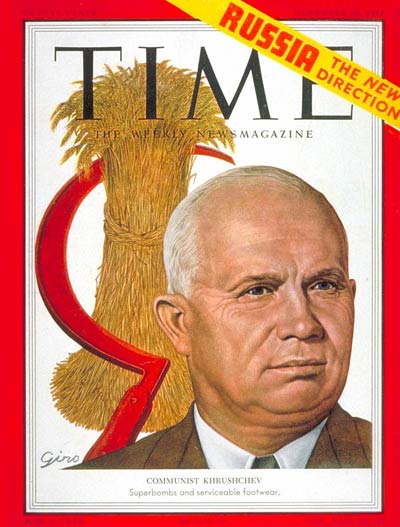
Khruschev’s Reforms
Khrushchev introduced a series of reforms as part of his Destalinisation programme. He advocated a Leninist approach to the economy and society. Khrushchev relaxed censorship rules. There followed a large number of artists and writers freely expressing themselves. A more open policy was adopted with other countries. This led to increased Soviet involvement in international events and new trading opportunities. Reforms saw the emergence of consumerism and a shift away from collective housing arrangements. Khrushchev’s reforms changed Soviet society. They weakened the Communist party by creating a split between his supporters and pro-Stalinists. Many of the reforms were reversed by his successor, Leonid Brezhnev.
Administrative Changes
Khrushchev brought about an end to some practises that had led to malpractice. These included ending the “Secret Envelope” system for bureaucrats. Under this scheme, administrative workers could receive cash bonuses on top of their wages. By ending it, Khrushchev was aiming to reduce corruption and also ensure a fairer more socialist set up.
The Twenty Second party congress introduced a time limit on a party members time in a particular role. This could generate an environment in which new ideas were brought forward, where workers were motivated to do their best to gain an equal or better role at the end of their existing position. In reality, it did neither. Most bureaucrats were worried about their status as the vast majority had been appointed under Stalin and the Destalinisation programme put them at risk.
The Party was restructured. In November, 1962, Committees were established for Agriculture and Industry. While this allows for specialisms to be developed, there was limited overlap and communications between the new sections meant that worker shortages in Agriculture were not addressed effectively. As the party was now split into two sections there were also two party secretaries. This led to leadership problems as the positions were deemed equal. Elections to the Central Committee were made difficult as a result of this division.
Agriculture
The reforms saw the establishing of 107 Sovnarkhozes, Regional Councils, to oversee production. Taxation on the small holdings that peasants were allowed to retain were cut. Collective Farms were encouraged to combine to create larger, more efficient farms. This built on the successes of the better farms.
A number of areas for new agricultural developments were begun. This ‘Virgin Lands’ programme aimed to boost production of key crops. The Virgin Lands Scheme was to cultivate 13 million hectares of previously unfarmed land. The land was to the East of the Volga, in Western Siberia, Kazakhstan and the Northern Caucasus regions. The programme saw 400,000 Komsomol volunteers migrate to the designated lands. Productivity in these areas was variable. In some years, yields were high, in others droughts struck.
Educational Reform
Education saw some large changes. Fees for attending school were abolished. This had a long term positive impact on standards in the USSR. At a higher level, polytechnics were reintroduced. These did provide specialist training in trades but in many places, especially rural areas, there were insufficient numbers of qualified teachers.
The length of schooling was also increased by a year. The extra year had a focus on skills needed in the workplace. Courses were developed for workers to attend at weekends, in holidays and as evening courses. This meant that workers were now able to gain additional qualifications which could see them move up the hierarchy within their industry.
The Education Reforms faced problems and opposition. Factories were ill equipped to deal with the change in the number of skilled workers. The skillset had developed faster than the shop floor could cope with. Academics were not pleased with the nature of the extra classes. For some, it watered down the standards too much.
Legal Reform
Under Khrushchev the NKVD was disbanded. It was replaced by the KGB. The KGB was answerable to the Communist Party. It’s recruits came from the Communist Youth League.
Links
Russian and Soviet History – Collectivisation under Stalin – What was the impact of Soviet Social Reform? – Destalinisation – Failure of Reform and the Decline of the Communist State

